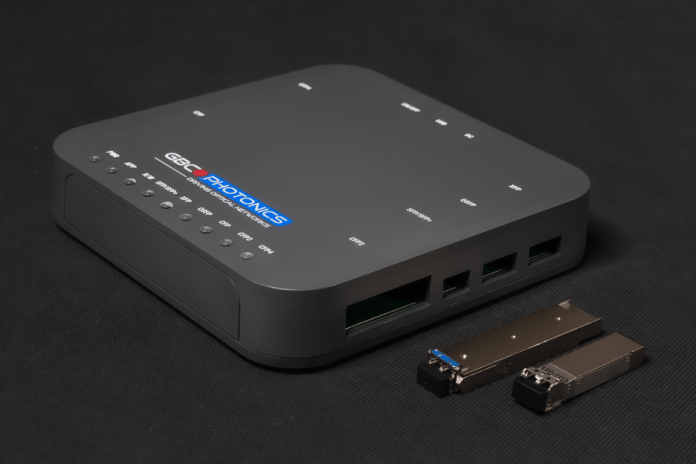The ample choice of optical transceiver providers and their comprehensive product portfolios give network operators the option to design their links in any configuration. While this is a great benefit, it can also lead to incompatibility between interfaces from different providers and cause disruptions.
The optical transceiver market is constantly evolving and developing new capabilities to respond to changing customer demand. Providers are offering new, updated interfaces for every need. For network operators, choosing products from different providers might seem like a smart choice, but it can also lead to incompatibilities between the products.
To make network configuration easier, operators can deploy universal optical transceivers by using GBC Photonics’ Simple Recode Device (SRD). The SRD allows users to alter the configuration of different types of transceivers — SFP/ SFP+/ SFP28/ XFP/ QSFP+/ QSFP28/ QSFP-DD/ CFP/ CFP2/ CFP4 — by modifying their memory in accordance with the appropriate MSA standard.
As a result, users will be able to operate different vendor-specific modules with one universal optical transceiver. Such an approach helps operators optimise all processes related to optical transceivers, like network planning, maintenance, purchasing, stocking and many more.
The easy reconfiguration process guarantees compatibility and offers a wealth of other benefits on top.

GBC Photonics’ SRD allows users to change the configuration of different types of transceivers by modifying their memory in accordance with the appropriate MSA standard. (Source: GBC Photonics)
Easier implementation
Dealing with a wide variety of optical transceivers and interfaces can be frustrating and time-consuming — even after careful consideration, there’s always the chance that your transceiver of choice won’t be supported by the device you need to set up.
The causes can be many, such as human error, incorrect or incomplete inventory information, or communication problems with the client. Regardless of the reason, the only solution is to replace the transceiver. Operators will waste time going back and forth from the warehouse, and if the new transceiver is not in stock, the implementation will have to be postponed.
With a universal transceiver, operators will save time and money, leading to a more efficient implementation and to increased customer satisfaction.
Scalability and increased flexibility
Slow processing speed, plans for growing the business, or the need for more bandwidth are all great reasons to upgrade fiber networks. However, the initial investment in hardware is sometimes one of the reasons why companies postpone upgrades that could substantially improve performance.
Universal optical transceivers facilitate this process by minimizing the need to invest in new equipment, as well as reducing lead times for implementation. For example, if the upgrade requires the integration of equipment from a new vendor in the network infrastructure — for example, replacing all Juniper switches with Nokia switches, or vice versa — the company can simply reconfigure its existing transceivers without buying new ones. This will help keeping costs down while reducing the chances of equipment mismatch.
Solving supply chain issues
When components are hard to get, there’s nothing more useful than products that can be re-purposed for multiple applications. Networks tend to incorporate equipment from several vendors, and because most of them require the use of proprietary transceivers, operators will have to keep them all in stock.
Moreover, the share of equipment from a specific vendor in a network can change over time, as customers might decide to upgrade existing hardware with equipment from a different provider. This means that the matching transceivers will have to be replaced as well.
Universal optical transceivers eliminate the need to stock countless versions of the same product. At a time of supply chain shortages, re-purposing existing transceivers can be a blessing for service providers.
Reduced environmental footprint
The Global E-Waste Monitor warned that in 2019, 53.6 million tons of e-waste were produced globally. This is an increase of 2 million tons from the previous year, the equivalent of 200 Eiffel Towers. The same source predicts that e-waste will increase to 74.7 million tons by 2030. The telecommunications industry must do its part to prevent the catastrophic impact of pollution from e-waste, and one way of doing this is by minimizing hardware redundancies.
A universal optical transceiver means that when a network operator decides to implement equipment from a new vendor in their network infrastructure, they won’t need to discard their existing transceivers and buy new ones to match. Instead, they can simply reconfigure them and keep them in operation for as long as possible.
Vendor agnostic equipment that can be easily repurposed is the way to go for network operators who wish to stay competitive while responding to the global need to deliver more sustainable solutions. Universal optical transceivers are ideal solutions for easy and effective network configuration processes and one network operators should not overlook.
Advertisement





